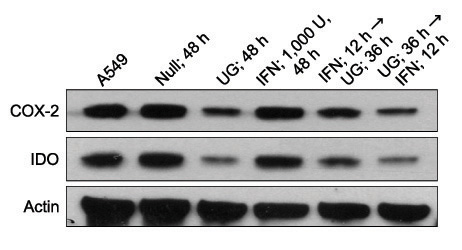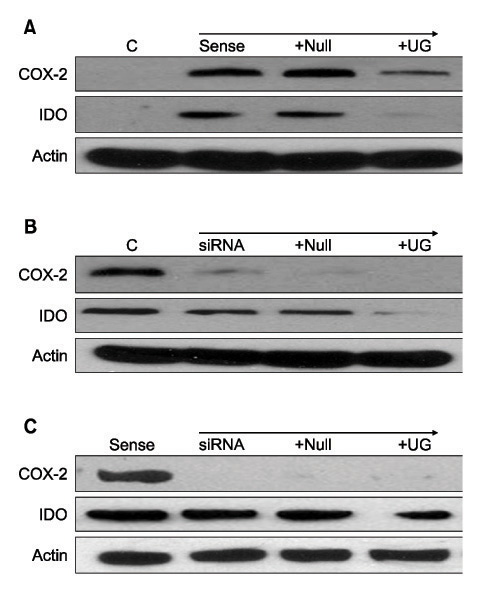Tuberc Respir Dis.
2009 Apr;66(4):274-279.
Expression of COX-2 and IDO by Uteroglobin Transduction in NSCLC Cell Lines
- Affiliations
-
- 1Department of Internal Medicine, Dongguk University Ilsan Hospital, Dongguk University College of Medicine, Gyeongju, Korea.
- 2Department of Internal Medicine and Lung Institute of Medical Research Center, Seoul National University College of Medicine, Seoul, Korea. ywkim@snu.ac.kr
- 3Respiratory Center, Department of Internal Medicine, Seoul National University Bundang Hospital, Seongnam, Korea.
Abstract
- BACKGROUND
Uteroglobin (UG) is a secretary protein that has strong immunomodulatory properties, and which is synthesized in most epithelia including lung tissue. Overexpression of UG is associated with decreased expression of cyclooxygenase (COX)-2 and suppression of cancer cell growth. Indoleamine 2,3-dioxygenase (IDO) catalyzes tryptophan along the kynurenine pathway, and both the reduction in local tryptophan and the production of tryptophan metabolites contribute to the immunosuppressive effects of IDO.
METHODS
In this study, we investigated the pattern of expression of COX-2 and IDO, and the effect of UG transduction in the expression of COX-2 and IDO in several non-small cell lung cancer cell lines, especially A549.
RESULTS
Both COX-2 and IDO were constitutionally expressed in A549 and H460 cells, and was reduced by UG transduction. In A549 cells, the slightly increased expression of COX-2 and IDO with the instillation of interferon-gamma (IFN-gamma) was reduced by UG transduction. However, the reduced expression of COX-2 and IDO by UG transduction was not increased with IFN-gamma instillation in A549 cells. In both the A549 COX-2 sense and the A549 COX-2 anti-sense small interfering RNA (siRNA)-transfected cells, IDO was expressed; expression was reduced by UG transduction, irrespective of the expression of COX-2.
CONCLUSION
The results suggest that the anti-proliferative function of UG may be associated with the immune tolerance pathway of IDO, which is independent of the COX-2 pathway.
Keyword
MeSH Terms
-
Carcinoma, Non-Small-Cell Lung
Cell Line
Constitution and Bylaws
Cyclooxygenase 2
Immune Tolerance
Indoleamine-Pyrrole 2,3,-Dioxygenase
Interferon-gamma
Kynurenine
Lung
Prostaglandin-Endoperoxide Synthases
RNA, Small Interfering
Tryptophan
Uteroglobin
Cyclooxygenase 2
Indoleamine-Pyrrole 2,3,-Dioxygenase
Interferon-gamma
Kynurenine
Prostaglandin-Endoperoxide Synthases
RNA, Small Interfering
Tryptophan
Uteroglobin
Figure
Reference
-
1. Mukherjee AB, Kundu GC, Mantile-Selvaggi G, Yuan CJ, Mandal AK, Chattopadhyay S, et al. Uteroglobin: a novel cytokine? Cell Mol Life Sci. 1999. 55:771–787.2. Linnoila RI, Szabo E, DeMayo F, Witschi H, Sabourin C, Malkinson A. The role of CC10 in pulmonary carcinogenesis: from a marker to tumor suppression. Ann N Y Acad Sci. 2000. 923:249–267.3. Szabo E, Goheer A, Witschi H, Linnoila RI. Overexpression of CC10 modifies neoplastic potential in lung cancer cells. Cell Growth Differ. 1998. 9:475–485.4. Zhang Z, Kundu GC, Panda D, Mandal AK, Mantile-Selvaggi G, Peri A, et al. Loss of transformed phenotype in cancer cells by overexpression of the uteroglobin gene. Proc Natl Acad Sci USA. 1999. 96:3963–3968.5. Kundu GC, Mandal AK, Zhang Z, Mantile-Selvaggi G, Mukherjee AB. Uteroglobin (UG) suppresses extracellular matrix invasion by normal and cancer cells that express the high affinity UG-binding proteins. J Biol Chem. 1998. 273:22819–22824.6. Hastürk S, Kemp B, Kalapurakal SK, Kurie JM, Hong WK, Lee JS. Expression of cyclooxygenase-1 and cyclooxygenase-2 in bronchial epithelium and nonsmall cell lung carcinoma. Cancer. 2002. 94:1023–1031.7. Yoon JM, Lim JJ, Yoo CG, Lee CT, Han SK, Shim YS, et al. The role of uteroglobin in the immunomodulation of nonsmall cell lung cancer cells. Tuberc Respir Dis. 2004. 57:336–344.8. Taylor MW, Feng GS. Relationship between interferon-gamma, indoleamine 2,3-dioxygenase, and tryptophan catabolism. FASEB J. 1991. 5:2516–2522.9. Burke F, Knowles RG, East N, Balkwill FR. The role of indoleamine 2,3-dioxygenase in the anti-tumour activity of human interferon-gamma in vivo. Int J Cancer. 1995. 60:115–122.10. Munn DH, Shafizadeh E, Attwood JT, Bondarev I, Pashine A, Mellor AL. Inhibition of T cell proliferation by macrophage tryptophan catabolism. J Exp Med. 1999. 189:1363–1372.11. Stone TW, Darlington LG. Endogenous kynurenines as targets for drug discovery and development. Nat Rev Drug Discov. 2002. 1:609–620.12. Blanco JC, Contursi C, Salkowski CA, DeWitt DL, Ozato K, Vogel SN. Interferon regulatory factor (IRF)-1 and IRF-2 regulate interferon gamma-dependent cyclooxygenase 2 expression. J Exp Med. 2000. 191:2131–2144.13. Marshall B, Keskin DB, Mellor AL. Regulation of prostaglandin synthesis and cell adhesion by antrytophan catabolizing enzyme. BMC Biochem. 2001. 2:5.14. Fallarino F, Grohmann U, Vacca C, Orabona C, Spreca A, Fioretti MC, et al. T cell apoptosis by kynurenines. Adv Exp Med Biol. 2003. 527:183–190.15. Munn DH, Mellor AL. Indoleamine 2,3-dioxygenase and tumor-induced tolerance. J Clin Invest. 2007. 117:1147–1154.16. Steinbrink K, Graulich E, Kubsch S, Knop J, Enk AH. CD4(+) and CD8(+) anergic T cells induced by interleukin-10-treated human dendritic cells display antigen-specific suppressor activity. Blood. 2002. 99:2468–2476.17. Huang M, Stolina M, Sharma S, Mao JT, Zhu L, Miller PW, et al. Non-small cell lung cancer cyclooxygenase-2-dependent regulation of cytokine balance in lymphocytes and macrophages: up-regulation of interleukin 10 and down-regulation of interleukin 12 production. Cancer Res. 1998. 58:1208–1216.18. Stolina M, Sharma S, Lin Y, Dohadwala M, Gardner B, Luo J, et al. Specific inhibition of cyclooxygenase 2 restores antitumor reactivity by altering the balance of IL-10 and IL-12 synthesis. J Immunol. 2000. 164:361–370.19. Lee JC, Park KH, Han SJ, Yoo CG, Lee CT, Han SK, et al. Inhibitory effect of adenovirus-uteroglobin transduction on the growth of lung cancer cell lines. Cancer Gene Ther. 2003. 10:287–293.20. Yoon JM, Lim JJ, Yoo CG, Lee CT, Bang YJ, Han SK, et al. Adenovirus-uteroglobin suppresses COX-2 expression via inhibition of NF-kappaB activity in lung cancer cells. Lung Cancer. 2005. 48:201–209.21. Mellor AL, Munn DH. IDO expression by dendritic cells: tolerance and tryptophan catabolism. Nat Rev Immunol. 2004. 4:762–774.22. von Bergwelt-Baildon MS, Popov A, Saric T, Chemnitz J, Classen S, Stoffel MS, et al. CD25 and indoleamine 2,3-dioxygenase are up-regulated by prostaglandin E2 and expressed by tumor-associated dendritic cells in vivo: additional mechanisms of T-cell inhibition. Blood. 2006. 108:228–237.23. Basu GD, Tinder TL, Bradley JM, Tu T, Hattrup CL, Pockaj BA, et al. Cyclooxygenase-2 inhibitor enhances the efficacy of a breast cancer vaccine: role of IDO. J Immunol. 2006. 177:2391–2402.
- Full Text Links
- Actions
-
Cited
- CITED
-
- Close
- Share
- Similar articles
-
- Effect of Uteroglobin on cPLA2, COX-2 Expression and ERK Activation in NSCLC Cells
- The Role of Uteroglobin in the Immunomodulation of Nonsmall Cell Lung Cancer Cells
- Clara Cell Secretory Protein
- Relation between Cyclooxygenase-2 and Polo-like Kinase-1 in Non-Small Cell Lung Cancer
- The Expression of Extracellular Signal Regulated Kinase (ERK) in Non-Small Cell Lung Carcinoma




